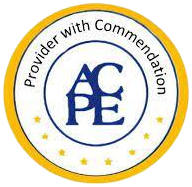Facilitating Improved Transitions: Supporting the Patient Journey from Curative Care to Hospice
Planned in cooperation with the ASHP SAG on Pain and Palliative Care
ACPE Activity Number: 0204-0000-23-568-H01-P
Release Date: 8/17/2023
Expiration Date: 8/17/2026
Activity Type: Knowledge-based
CE Credits: 1.0 contact hour, (0.10 CEUs)
Activity Fee: Member – Free / Non-Member – Not Available
This activity is a recording from a live webinar and those that claim credit for the live webinar should not claim credit for this activity.
Activity Overview
Palliative care is a specialized area of medical care for anyone living with serious illness. Similar to hospice care, it focuses on providing relief of symptoms and stress of the illness while improving quality of life for patients and their families. Unlike hospice care, palliative care can be delivered alongside treatment of the underlying illness(es). Hospice care should be considered for a terminal illness when treatment is considered no longer effective, the potential risks of treatment outweigh the potential benefits, and/or the patient no longer wishes to receive medical treatment for the terminal illness. The transition from a palliative approach to hospice care can be improved through timely goals of care conversations, identification of medications no longer contributing to symptom relief, and coordination of comprehensive care for unmet physical, emotional, and spiritual needs. In this session, we will discuss how the pharmacist can play a pivotal role across this spectrum of patient care.
Accreditation

The American Society of Health-System Pharmacists is accredited by the Accreditation Council for Pharmacy Education as a provider of continuing pharmacy education with Commendation.
Target Audience
This activity was planned to meet the educational needs of pharmacists caring for patients with chronic and/or serious illness.
Learning Objectives
After completing this activity, the learner should be able to…
- Identify the similarities and differences between palliative care and hospice.
- Discuss patient care interventions across the disease continuum of primary and specialty palliative care.
- Describe the role of the pharmacist in care coordination and symptom management when patients transition from a curative approach to their disease state(s) to hospice care.
Schedule of Activities
-
Introduction and Announcements
-
Presentation
-
Questions, Answers, and Discussion
Faculty
Michelle Schmidt, PharmD, BCGP
Clinical Assistant Professor, Hospice & Palliative Care
University of Iowa College of Pharmacy
Clinical Pharmacy Specialist, Adult Supportive & Palliative Care
University of Iowa Hospitals & Clinics
Iowa City, IA
Alison Duffy, PharmD, BCOP
Associate Professor
Department of Practice, Sciences, and Health Outcomes Research
University of Maryland School of Pharmacy
Clinical Specialist, Oncology
University of Maryland Medical Center
Baltimore, MD
Moderator and Speaker
Traci White, PharmD, PhC, BCGP
Assistant Professor, Pharmacy Practice and Administrative Sciences
University of New Mexico College of Pharmacy
Clinical Pharmacy Specialist, Oncology and Palliative Care
Memorial Medical Center
Las Cruces, NM
Relevant Financial Relationship Disclosure
In accordance with our accreditor’s Standards of Integrity and Independence in Accredited Continuing Education, ASHP requires that all individuals in control of content disclose all financial relationships with ineligible companies. An individual has a relevant financial relationship if they have had a financial relationship with an ineligible company in any dollar amount in the past 24 months and the educational content that the individual controls is related to the business lines or products of the ineligible company.
An ineligible company is any entity producing, marketing, re-selling, or distributing health care goods or services consumed by, or used on, patients. The presence or absence of relevant financial relationships will be disclosed to the activity audience.
-
No one in control of the content of this activity has a relevant financial relationship (RFR) with an ineligible company.
Methods and CE Requirements
This activity consists of recordings of faculty slides presentations, active learning activities, discussion, and handouts. Participants must participate in the activity in its entirety to claim continuing pharmacy education credit online at ASHP Learning Center. Follow the prompts online to complete the evaluation, claim credit and view the statement of credit immediately after completing the activity.
Per ACPE requirements, CPE credit must be claimed within 60 days of being earned. Once you have processed and claimed your CE credit, we encourage you to check your NABP eProfile account to verify your credits were transferred successfully before the ACPE 60-day deadline. It is an electronic direct-report process so your credits should appear in your account within a few minutes. After the 60 day deadline, ASHP will no longer be able to report your credit(s) for this activity.
